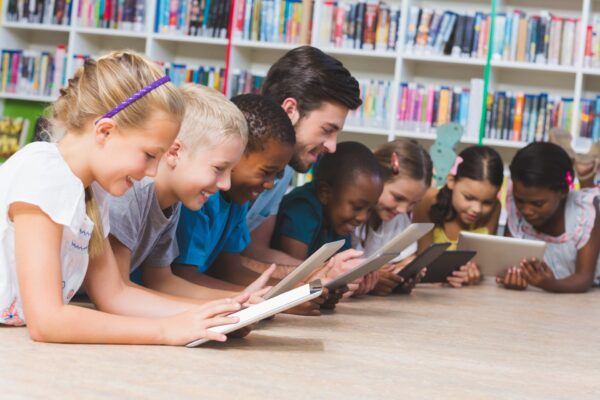Key points:
- Tech for tech’s sake won’t work without great teachers behind the tools
- Discover some of the best technologies that improve student learning
- Stay up-to-date on all things concerning learning in the digital age
Examples of leveraging technology in K-12 learning showcase innovative ways to engage students. From interactive apps and virtual field trips to adaptive learning platforms, these tools enhance comprehension and prepare students for learning in the digital age. Let’s delve into some compelling instances where technology elevates the educational experience.
What are some good examples of using technology to enhance learning?
Several impactful examples of technologies that improve student learning illustrate how technology enhances K-12 experiences, transforming traditional education into dynamic and engaging experiences. Adaptive learning platforms, such as DreamBox or Khan Academy, personalize instruction, tailoring lessons based on individual student progress and needs.
Virtual field trips, facilitated by platforms like Google Expeditions, bring immersive experiences into the classroom, transporting students to historical landmarks, ecosystems, or outer space. This fosters experiential learning and makes abstract concepts tangible.
Coding programs, like Scratch or Code.org, introduce students to programming in a playful manner, promoting critical thinking and problem-solving skills. Augmented reality applications, such as Quiver or Elements 4D, overlay digital content onto physical objects, enhancing visual and interactive learning.
Online collaboration tools like Padlet or Flipgrid encourage teamwork and communication, allowing students to collaborate on projects, share ideas, and engage in interactive discussions beyond the physical classroom. These examples collectively showcase how technology not only enriches educational content but also creates a more inclusive, interactive, and student-centered learning environment in K-12 settings.
How teachers use technology in the classroom
Teachers in K-12 classrooms leverage technology tools for teaching and learning in diverse ways to enhance teaching methodologies and create dynamic learning environments. Interactive whiteboards facilitate multimedia-rich presentations, allowing educators to illustrate concepts vividly and encourage student participation.
Teachers also utilize online collaboration tools, such as Google Workspace or Microsoft Teams, to foster teamwork and communication among students. Adaptive learning platforms tailor instruction, ensuring personalized learning experiences that address individual strengths and weaknesses.
Additionally, virtual reality applications and online simulations immerse students in interactive experiences, making abstract concepts more tangible and engaging. Coding programs and robotics kits introduce hands-on learning, promoting critical thinking and problem-solving skills.
Overall, the integration of technology empowers educators to create student-centered, interactive, and efficient classrooms that cater to the evolving needs of 21st-century learners.
What are 3 benefits of using technology in education?
The integration of technology in education and benefits of technology in the classroom bring forth numerous benefits, transforming traditional learning methods and enriching the educational experience. Firstly, technology enhances accessibility to information. Students can access a vast array of online resources, e-books, and educational databases, breaking down geographical barriers and providing a globalized learning experience.
Secondly, technology promotes interactive and personalized learning. Educational apps, online platforms, and adaptive learning systems cater to diverse learning styles, making lessons more dynamic and engaging. This personalization addresses individual student needs, allowing for self-paced learning and a deeper understanding of subjects.
Thirdly, technology fosters essential 21st-century skills. Students gain proficiency in digital literacy, critical thinking, and problem-solving through exposure to coding programs, collaborative online tools, and interactive simulations. These skills are paramount in preparing students for the challenges of the modern workforce.
The incorporation of technology in education not only increases access to information but also cultivates a more interactive, personalized, and skill-oriented learning environment. As technology continues to evolve, its positive impact on education is likely to expand, creating innovative and effective learning experiences for students at all levels of education.
How do teachers use technology to enhance the learning experience?
Teachers leverage technology to enhance the learning experience in multifaceted ways, highlighting the importance of technology in the classroom.
Educational apps and online platforms cater to diverse learning styles, providing interactive lessons and assessments tailored to individual needs. Virtual field trips, facilitated by technology like virtual reality applications, bring real-world experiences into the classroom, fostering experiential learning.
Adaptive learning platforms tailor instruction, ensuring personalized learning experiences that address individual student strengths and weaknesses. Coding programs and robotics kits introduce hands-on learning, promoting critical thinking and problem-solving skills.
Furthermore, online collaboration tools like Google Workspace or Microsoft Teams facilitate real-time communication and teamwork, enabling students to collaborate on projects and engage in interactive discussions.
Technology becomes a versatile tool for educators, enhancing engagement, personalization, and collaboration in the classroom. By integrating these technological tools judiciously, teachers create dynamic and effective learning environments that cater to the diverse needs of students and prepare them for the challenges of the digital age.
Conclusion
The integration of technology in K-12 classrooms significantly elevates the learning experience. From personalized instruction and interactive tools to collaborative platforms, technology fosters engagement and prepares learners for the future. Its positive impact continues to reshape education, creating dynamic, inclusive, and effective learning environments.
- Most parents know AI will be crucial to their children’s future - October 15, 2024
- Use of Technology in the Classroom to Enhance Teaching and Learning - September 26, 2024
- How Does Technology in the Classroom Help Teachers? - September 26, 2024


